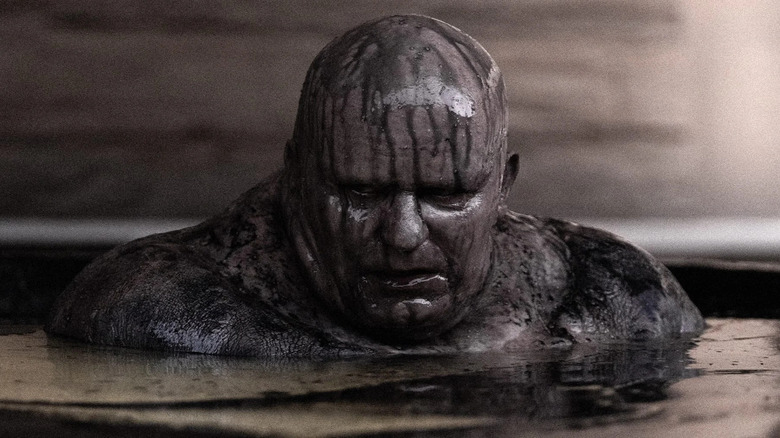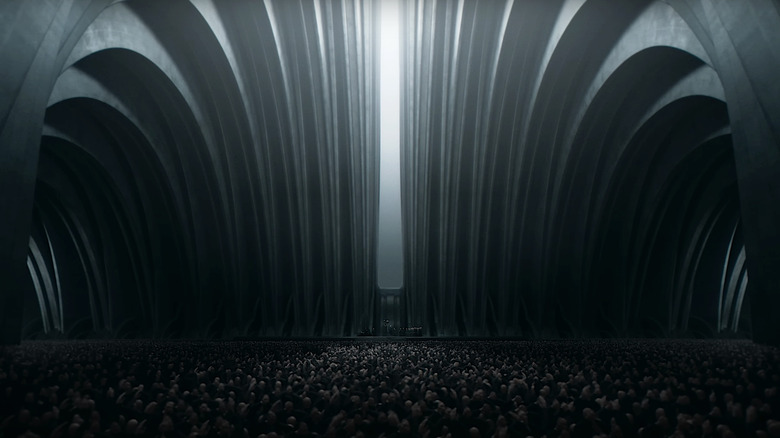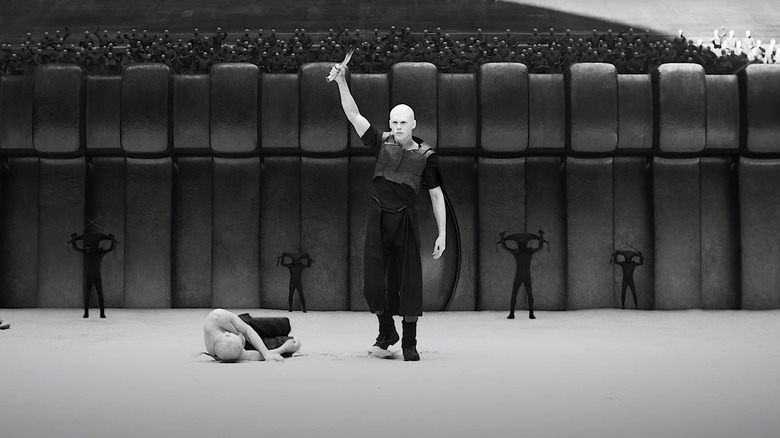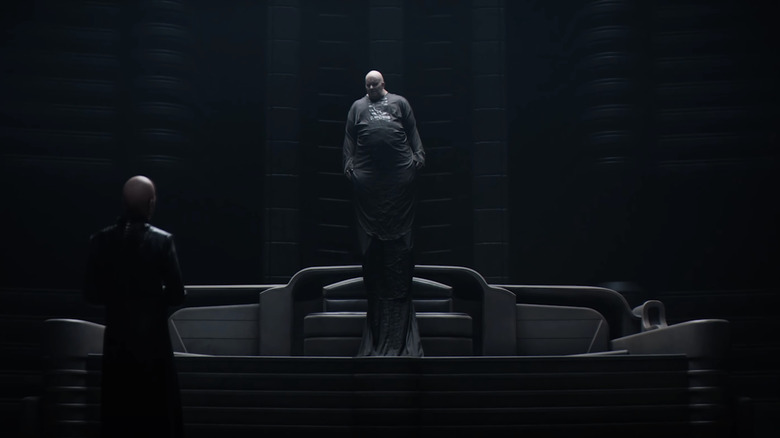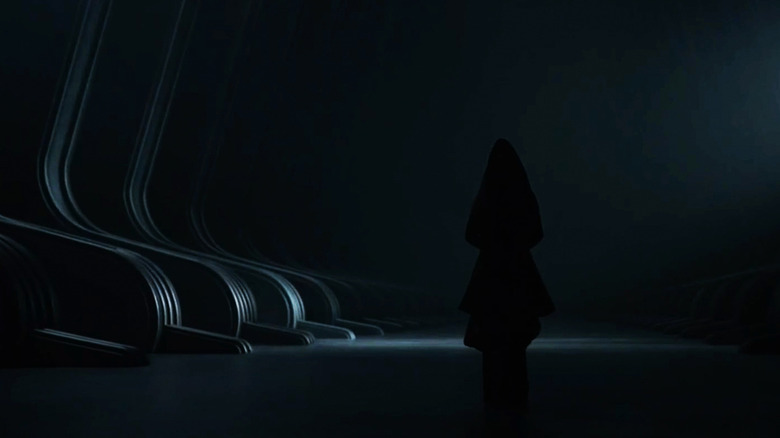How A 'Field Full Of Septic Tanks' Inspired Part Of Dune's Landscapes
Sci-fi production design may well have peaked with "Blade Runner." This quote from director Christopher Nolan is a favorite of mine, simply because of how well it sums up the way in which Ridley Scott's 1982 classic, despite its fantastical sci-fi aesthetic, constructs a world that feels real:
"The atmosphere of 'Blade Runner' was also important, that feeling that there was this whole world outside the frame of the scene. You really felt there were things going on outside of those rooms where you've seen the film take place [...] Every film should have its own world, a logic and feel to it that expands beyond the exact image that the audience is seeing."
Nolan has previously spoken about the importance of establishing a "cinematic reality" — evoking a feeling in the audience that what they're seeing, regardless of its factual accuracy, is really happening. It's a trick I think Denis Villeneuve managed to pull off impressively well with the 2017 "Blade Runner" sequel that was too good to be a box office hit, "Blade Runner 2049."
But what about Villeneuve's "Dune" movies? Did he manage to do it again? Well, regardless of how you or I feel about it, there's no doubt the production design in both "Dune" and "Dune: Part Two" is an artistic and technical feat with an array of influences. One of which, you might be surprised to learn, was septic tanks.
Denis Villeneuve came to Dune with a fresh perspective
When it came to adapting Frank Herbert's supposedly "unfilmable" 1965 novel "Dune," Denis Villeneuve instructed the creative team not to use any references from other adaptations, including previous movies, book illustrations, and fan art. As a result, "Dune" and its sequel feel original in their aesthetic. It's the same principle that guided the "Blade Runner" production design. Instead of clean and clinical sci-fi environs, Ridley Scott's seminal 1982 effort presented a world that felt as though it had undergone some horrific mutation and was now stuck half-way between a technological revolution and a crumbling industrial empire.
"Blade Runner 2049" did an admirable job of maintaining the look and feel of Scott's original. But with "Dune," Villeneueve wasn't shackled to any previous films. He and his team were truly free to interpret the world from Herbert's novel how they saw fit, with the French Canadian filmmaker imploring his team to refer to Herbert's original novel as much as possible. But while the novel was the production's north star, it wasn't the sole source of inspiration. In fact, there were some truly unique influences on the aesthetic of "Dune" and "Dune: Part Two."
How Dune's production designer created Giedi Prime
"Dune" and "Dune: Part Two" don't share the same aesthetic as "Blade Runner" but the principle of approaching the look of the film with an open mind is exactly the same. With Frank Herbert's book as their guide, Denis Villeneuve and his crew borrowed from an overwhelming list of sources to create the various environments in the movies. So far, we've learned that everything from "Star Wars" scenes to Rolex watches inspired the look of "Dune" and "Dune: Part Two." But how on earth do septic tanks fit into the whole thing?
In a Pushing Pixels interview, production designer Patrice Vermette was asked specifically about creating the look of Giedi Prime, home to the villainous House Harkonnen. In "Dune: Part Two," the scenes taking place on this planet were shot in black-and-white using infrared in an attempt to visualize how a planet with a black sun might look. Geidi Prime is also where Austin Butler's bald assassin Feyd-Rautha faces off against an unnamed soldier early in "Dune: Part Two," demonstrating his supreme combat skills at the Arena in the planet's capital of Barony. In his interview, Vermette said:
"Giedi Prime was a lot of fun to design. It's a planet that has been over-exploited by the Harkonnens. When we think about our world on planet Earth, global warming, over exploitation of natural resources, we also think about our dependency to oil. It has this black viscous quality to it. Denis always had in mind a black molded plastic world. References to brutalism and post modernism are also very present but has a twist to them."
So how, then, did Vermette manage to work in septic tanks? Well, the key was in the "black molded plastic."
Giedi Prime was partly inspired by septic tanks
As Patrice Vermette explained in his interview, it was during a drive through the country that he first got the inspiration for his septic tank-inspired set design for Geidi Prime:
"One day, while I was driving on a country road outside Montreal, I came across this field full of septic tanks. They were all made of black plastic. It was kind of an epiphany. It all made sense. Septic tanks and their molds have quite interesting shapes. And besides that, what do you find inside septic tanks?"
This sanitary-inspired theme seemed to work, as Vermette won an Oscar for "Dune" (one of the many Oscar winners the Academy decided weren't worth your attention in 2022). This theme carried over to "Part Two," where Vermette expanded on the idea for the besieged Arrakeen city. As explained in the book "The Art and Soul of Dune: Part Two," this location was invaded by Harkonnen forces, who'd built their own structures on top of the previous buildings:
"Both the Arrakis spaceport and the city of Arrakeen had been badly damaged in the first film. 'Part Two' would feature these same locations to illustrate the aftermath of the attack and how the enemy had invaded the landscape. Denis suggested building structures on top of the rubble, 'Imagine huge, black, plastic insectoid shapes emerging from the ruins, as though the Harkonnens have brought their world with them.'"
According to the book, Vermette saw the perfect opportunity to bring up his septic tank inspiration once again, telling Villeneuve, "You're going to laugh, but do you know what I find inspiring? Septic tanks." The director evidently found this funny, with Vermette adding, "Black, shiny, and new" to further sell the idea.
The Dune movies are impressive but bleak
Overall, the effort that went into crafting the look of "Dune" and "Dune: Part Two" is undeniable. There's a reason Patrice Vermette won an Oscar for his work on the first film, and the visual effects team also won an Oscar for theirs. The septic tank inspiration is just a small part of an extremely eclectic and diverse whole, which ultimately gives Denis Villeneueve's films a real sense of immersion.
But, for me, "Dune" and "Dune: Part Two" are little too bleak. They don't feel as visceral and all-enveloping as something like "Blade Runner." There's no doubt the environments in these films feel otherworldly, interesting, coherent, and finely-crafted, but I don't get the same feeling of incongruous realism that I did with "Blade Runner."
A lot of this is obviously subjective, and the story of "Dune" itself is a wholly different thing to that of "Blade Runner." The distant worlds of "Dune" are not the dystopian Los Angeles of 2019 presented in "Blade Runner." What's more, "Dune" is often cited as providing much of the blueprint for sci-fi aesthetics that emerged throughout the second half of the 20th century. With Villeneuve and his team dedicating themselves to the book as source material, a lot of the film was always going to feel familiar, even while the director and Vermette allowed themselves to draw from a wide-array of inspirations. So while the Rolex and septic-tank-inspired aesthetic doesn't quite live up to that of "Blade Runner," not much does. Villeneuve, Vermette, and the "Dune" crew still deserve all the praise they get.
